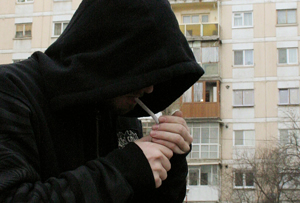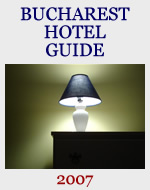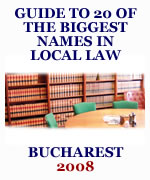Invisible addiction
With one per cent of Bucharest’s population addicted to heroin, ‘The Diplomat’ reports on a drug attacking poor communities and children as young as nine years old. Report by Michael Bird
 |
|
|||||||||||||
“I’ve just been to the head doctor!” says a thin late teen in a baseball cap and anorak, talking to his friend in the reception area of a methadone treatment centre in Stefan Cel Mare, Bucharest.
“Was she pretty?” asks his friend, a 20 year-old in a hooded jacket.
He pauses.
“Yeah,” he adds, unconvinced.
The first boy is showing his friend the centre in the ‘Matei Bals’ Institute for Infectious Diseases, where around 200 of Bucharest’s 25,000 heroin addicts come to help themselves off the drugs with a course of opiate substitute, methadone.
The first boy shows his friend a table piled up with a giant pyramid of condoms.
“Look,” he says, “they’re all free! You can take as many as you like.”
“But,” says the second boy. “I’m not infected.”
In the clinical two-room building, former and mildly active drug users drop in, walk up to a water cooler, pull out a cup and pour it full. They sign in with a chemist, and then pop their methadone pills.
The institute used to allow users to take away the medication. But this encouraged some to pocket the pills and sell them on the street – where their value can be worth up to 20 times the wholesale cost.
Now, if most users want to take home the pills, the chemist crushes them with a pestle and mortar and then puts the remains in a plastic bag.
'1') {
require('php/art_auth.inc');
}
?>
“Dealers can’t sell a mashed-up pill,” says Dr Adrian Abagiu, a specialist doctor running the centre. “But,” he adds, sadly, “the users can still shoot it up.”
Methadone cuts out the bad symptoms, but it does not give the user a high. Some ex-addicts still have the urge to use a syringe. They need the ritual. So they will take the methadone while injecting themselves with water. The cost for the treatment is around 100 Euro a month. But this is free for the pregnant or those who are HIV positive.
Abagiu admits that in the early days of the centre there were some addicts who came for treatment as a holiday from the needle. “They were regular vascular users, but did not have any veins left,” he says. Instead they took methadone for one month, to give time to build up their veins.
“I had to go on methadone because the next step was stealing from the street,” says Andrei, 28, who used heroin for four years.
He now works in retail and takes 15 methadone pills daily from his local hospital.
“When I took them for the first two weeks, it was much like heroin,” he says. “But I didn’t feel sick, my bones didn’t hurt and my stomach didn’t ache.”
The switch also transformed his lifestyle.
“I didn’t worry about money for drugs,” he adds. “I didn’t have to wake up in the morning wondering where I could get some cash. I wouldn’t have to wait on a pavement in the rain or snow waiting for a dealer who could be three hours late.”
Now he wants to decrease his dosage and come clean by the Summer.
“After coming off heroin,” says Andrei. “I felt like I had been trapped in a box for four years of my life.”
Youth target
The oldest patient undergoing treatment at the Matei Bals-based clinic is 54 years old, but Dr Abagiu sees the biggest problem among the young. “The main problem in Romania compared to other countries is the number of children using drugs,” he says.
While the average age of a user is 20, children as young as nine are using heroin in Romania. Abagiu has also played host to a 16 year-old user with a five-year history of taking the drug. He wanted methadone replacement, but could only do so with parental consent. The kid did not understand. He said he could pay hundreds of Euro, if that was what it would take. He could find the money. The law does not allow anyone under 16 to gain methadone treatment. Nor does the law allow the medical services to distribute free needles to children, or to test them for infections.
“A lot of children under 16 are heavy users,” says Abagiu. “They come to us, but we can’t really help them, because it’s not legal.”
Some of these are homeless street-kids moving to Bucharest to make money. The lack of education, community and communication in these sectors does not help.
“Some don’t even know the word heroin,” adds Valentin Simionov, director of the Romanian Harm Reduction Network, an NGO group coordinating treatment and prevention of drug use. “They don’t know what it’s called. It’s just known as ‘marfa’ – the stuff.”
Drug history
In 1989 there were no heroin addicts in Romania, now one per cent of Bucharest is shooting up the narcotic. The city has become Romania’s drug capital because of its money, development, nightlife and urban anonymity which encourages a spirit of experimentation.
“The main problem [with drugs] is the growth of heroin users in Bucharest,” says Pavel Abraham, director of the National Anti-Drugs Agency.
It is present in all sectors of society, including students, office workers, Governmental officials and diplomats. It is also popular among the homeless who have graduated onto heroin after inhaling metal paint aurolac. “We have clients that use both drugs,” says Cristina Fierbinteanu, project manager at a needle exchange unit for the Romanian Association Against AIDS (ARAS). “When they cannot get heroin, they use aurolac.”
Except for some cannabis use in Constanta and university towns in the 1970s, Romania was drug-free during Communism. Then, during the 1990s, Romania became an attractive zone for traffickers due to the difficulty of transporting drugs through Yugoslavia, owing to its civil war.
In the mid 1990s, heroin was popular in universities. Children and students from wealthy and reputable families ended up in rehab abroad. Then it hit the street and also became the drug of the poor.
Now heroin comes to Romania from Afghanistan, through Iran, Turkey and Bulgaria. Romania’s ports, including Constanta, are transit points for drugs, where they are often hidden in containers of canned fruit.
Meanwhile cocaine comes from South America to Africa and then to Constanta. Some Romanians living abroad, in Spain and Italy, bring cocaine and Moroccan cannabis back home. They are affiliated to international crime networks, which are testing the Romanian market.
“Cocaine and cannabis have been coming from Spain and Africa in the last three years,” says Abraham. “This will increase. We have to understand the realities after EU integration.”
Public enemy
Drug users in Romania distrust society. This includes hospitals and pharmacies, many of which still refuse to sell needles to addicts. This encourages the exchange of syringes, which can lead to Hepatitis C or HIV spreading.
The six methadone treatment centres are now reaching up to ten per cent of the addicts in the Capital. But there is an invisible majority of users who do not interface with treatment or prevention. “Even if we have more centres, we would have problems attracting users – they are scared of us and society,” argues Dr Eugen Hriscu, psychiatrist, National Centre for Medical Health.
The police also have a history of beating up users or asking for bribes.
One example is Ade, a 29 year-old Bucharest cannabis user, who was picked up by a policeman late at night outside a block.
“He asked to search through our bags,” says Ade. “Inside he found a small packet of weed. He asked what this was. I said it was some tea that I bought for a bad throat. He took me in a car to the station, parked outside and said: ‘Are you going to come clean or do I have to take you inside?’
“I said: ‘Okay it’s dope.’ He added: ‘I know, but do you want to go to the station or not?’ I asked him whether one hundred dollars was okay. He said that was fine. I called my girlfriend, who brought the money. She handed it to the cop and he let me go.”
Another story is from ex-heroin user Andrei, 28, who was visiting his dealer in a block, while his friend stayed outside in a car. When Andrei returned, with the heroin hidden in a secret pocket, he saw there were two men in the back of the car. They came out of the vehicle and started to threaten him, then punched him in the stomach.
Both were policeman. They searched him and found no drugs. But they did discover some silver foil which he had used to smoke heroin.
They kept him in jail for eight hours.
“They know that after this amount of time you will really need some heroin,” says Andrei.
The police interrogated him, and told him that if he did not cooperate, he could see up to three years in prison. Then a police officer picked on another person locked up in an overnight cell, asking the prisoner to hand over some money, worth around ten Euro. The officer wrote down the serial number on the cash-note, gave it to Andrei and told him to go back to the dealer the next morning. He agreed. Then the police arrested the dealer with the marked money as proof the exchange had taken place.
Possession paradox
In Romania, possession of drugs is a crime, but consumption is not illegal. If a user is carrying one gram of heroin, he risks conviction. But if he is injecting this into his vein, he is a victim of his own abuse. Many doctors and social workers see this as paradoxical and impractical.
“Whenever the police pick up a user, he may swallow his entire load even if he doesn’t want to, just to avoid prosecution,” says Hriscu. “The more the police come down on users, the further they drive use underground.”
In many western countries there is a difference between possession for personal use and dealing, based on the quantity of the drug. Carrying more than six grams could show a propensity to dealing, while possession of anything less could carry only a fine.
“We haven’t specified in law the quantity [that denotes possession],” says Abraham. “We have a working group with the Ministry of Justice and want to come up with some improvements in the law.”
In individual cases, prosecutors and judges debate whether the amount is for personal use and make their decision based on that information. “The sentence depends on the court,” says Hriscu. “How good is the user’s lawyer and his luck with a judge.”
Shake the disease
The rate of Hepatitis C among intravenous heroin users in Bucharest is out of control. Carriers of the disease, which causes liver cancer, number around 90 per cent of the country’s heroin users, twice the EU average.
Only one per cent of the same users are HIV positive. Compared to many east European countries, Romania has a low rate, 11,000, of HIV sufferers in general. Only seven cases of HIV were recorded among intravenous drug users in the first six months of 2007. Most users believe there are more HIV carriers than recorded, but there is no proof.
“The low HIV numbers are a strong point of our system,” says Abraham, “but the biggest problem is Hepatitis C.”
Because Hepatitis C spreads due to the culture of sharing needles in groups, many experts believe the number of HIV sufferers among drug addicts is set to increase. This is also due to the growing link between sex workers and drug users. The more these two groups overlap, the bigger the problem.
“It’s not a matter of if, but a matter of when,” says Hriscu. “All conditions are available for an HIV epidemic to start. HIV spreads like wildfire.”
Prevention strategy
There are three non-governmental organisations running needle exchange programmes in Romania, the Alliance for the Struggle against Alcoholism and Drug Addiction (ALIAT), the Romanian Association Against AIDS (ARAS) and a local branch of the French NGO, Samu Social, which runs mobile units for the homeless. Volunteers freely give users a kit including a swab, needle, water and condom, take used needles and destroy them. ARAS has four outreach programmes in Bucharest, which move about the city and provide needles to addicts in their neighbourhoods. ARAS also has a presence in Constanta, Timisoara and Iasi, funded by the Global Fund to Fight AIDS. The needle exchange programmes reach about eight per cent of addicts or 3,000 people.
Evil weed
Cannabis usage in Romania is, officially, not as high as heroin use. The official attitude to the drug is a little different from the view on heroin. There are no plans to decriminalise or to classify cannabis as a ‘softer’ drug than heroin. The National Anti-Drugs Agency (ANA) does not believe in the concept of soft drugs.
“Cannabis is a drug more perverse than heroin, so perverse that it does not give painful signs,” says ANA director Pavel Abraham. “The risk in cannabis is disguised and postponed. Cannabis is as dangerous as heroin.”
But this attitude may have a counter-productive effect on the prevention of heroin use.
“The authorities put all drugs in one basket,” says psychiatrist Dr Eugen Hriscu. “There is no difference in the police’s attitude to possession of cannabis or heroin.” Potential users might as well take heroin as there is no incentive to take a substitute, he argues. “This is why there is a massive heroin problem, but not one with cannabis,” says the doctor.
But as the amount of disposable income increases, and a middle class emerges with western European influence, the popularity of this drug, along with party drugs such as amphetamines, is rising. “I don’t believe we will succeed to maintain the low level of cannabis consumption,” says Abraham.
“You know you do bad things to people who love you - but you can’t stop it”
Dan, aged 30, from Bucharest, on a history of heroin abuse
“1999 was when heroin came and found everyone. In every block in the Dristor neighbourhood in east Bucharest you could find someone who sold heroin. It was cheap – around 15 Euro a dose. The biggest importers were from Pakistan and Turkey, coming to Romania to sell to rich Roma, who then sold to the poor Roma, who were mostly users.
I was 21 and had been fighting with my girlfriend. I was working but staying with students in university halls. One night we wanted to smoke some weed, but it was finished, we couldn’t find someone to buy anymore. Then a friend turned up with some heroin. After three puffs I stopped feeling depressed.
Then I spent almost three years in one room with some friends. I went to work and then back to halls, smoked some heroin and a few joints, listened to music and talked about philosophy.
After 9/11, heroin was difficult to find. It forced me to quit and I was sick for a few months. Then I started injecting. The effect was instantaneous. Your body feels good from every point of view. On heroin you can go to work. You can focus. You can have sex for three hours without any problem. It makes you believe that all is going to be good and all problems will be solved.
However sometimes you suddenly fall asleep. I dozed off once while holding a cigarette in my fingers. The ash burnt down and I felt nothing, until I suddenly woke up and saw my hand was on fire.
The heroin was mixed with sleeping pills and anaesthetics. In the early 2000s it was 30 to 40 per cent pure, now it is only around ten per cent heroin.
Money was no problem. Somehow you find it. That’s the mystery no junkie can answer. You lie to your family. You take money from your friends and parents. Then you start to sell your stuff. I sold everything except my clothes.
I used the same vein in my left arm. I used to take about five doses a day – at a cost of about 40 Euro. I needed a dose to get out of bed in the morning. I was living with my parents but they never found out.
My dealer was a 40 year-old ex-boxer and taxi driver. He was a fat man who used to deal to a nurse. In return, she would lay him down, inspect his skin and find free veins to inject him.
It makes you lose your self-respect. You do not think you can do anything else. It makes you believe you don’t deserve to be with normal people. You know it’s bad and that you do bad things to people who love you – but you can’t stop it.
Once my heart stopped. My friend called the emergency services, saying I had an overdose. The woman on the other end of the telephone replied: ‘Why did you give him drugs?’ Then she hung up.
I had no job, no belongings, was weighing only 55 kg with a height of 1.85 metres, plus had 2,000 Euro in debt to moneylenders. I’d broken up with my girlfriend. All of my friends were junkies. I looked at myself in the mirror naked. It was as though I had just walked out of Auschwitz. I was so skinny. I could see my heart pumping between my ribs. I thought that if I did not stop now, I would die soon.
I told my parents. My mother had known something was wrong. I left Bucharest to stay with my grandmother. I was there for seven months and cut off all connections with my background in Bucharest. In the first three weeks, I took pills to cure the sickness. Then I got drunk on homemade wine and tuica and watched TV.
In the first month, you only experience physical pain. Then the heavy depression kicks in. You think you can’t do anything with your life.
It’s always present in my mind – like a voice telling me things. The first days after I stopped it became louder. I know it’s wrong. But it’s so convincing.
I’m 60 per cent sure I will not go back. Every birthday I make an exception and shoot up one dose. It’s like a present to my past.”

















